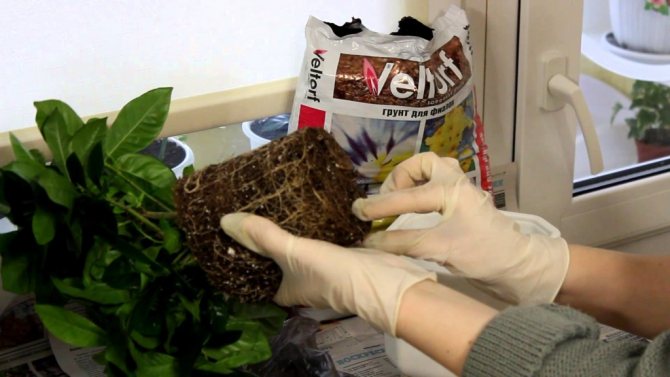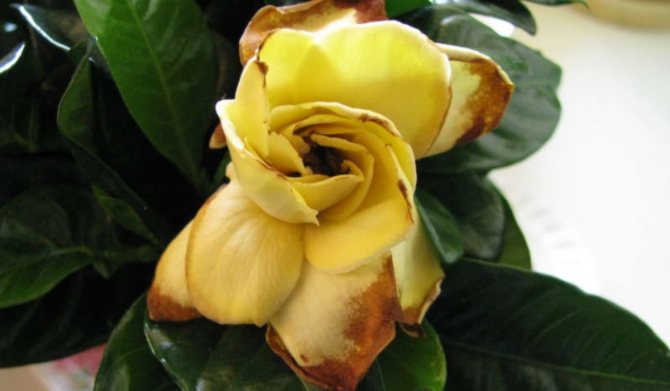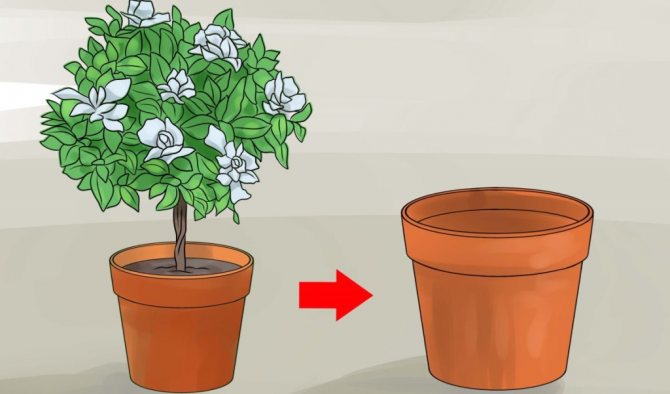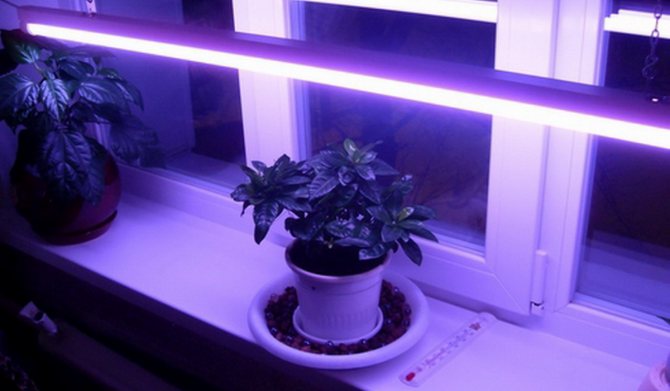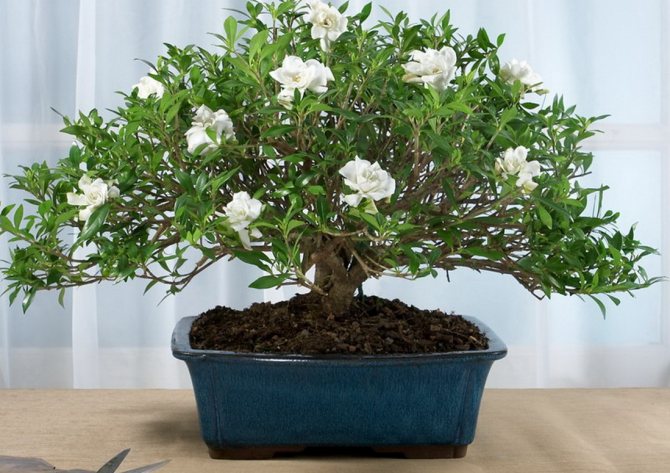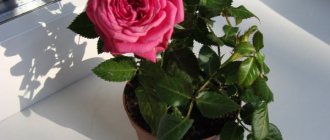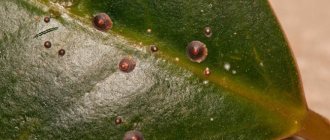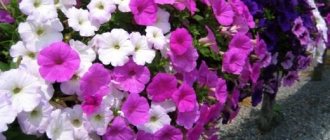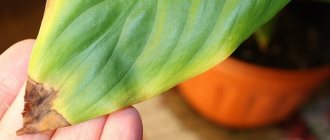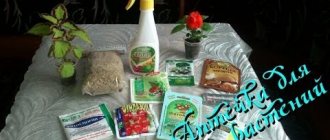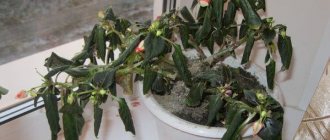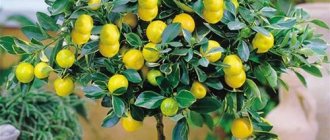Evergreen shrub gardenia jasmine will be the pride of the collection of indoor plants of any grower. But growing it is not at all easy. Gardenia does not belong to the category of unpretentious plants. Today we will consider the question of what to do if gardenia leaves turn yellow.
She is sensitive to any changes in conditions of detention, whether it is untimely or improper watering, changes in air temperature, low humidity or lack of nutrients in the soil. I don't like gardenias and bad weather. An exotic visitor from the subtropical forests of Japan, China and Africa loves bright sunny days, and when the sky is covered with clouds and it rains, she starts a real English spleen.
Gardenia refuses to bloom and may not open buds for a long time, waiting for better times. The most common gardenia unpleasant surprise that amateur growers often encounter is yellowing and dropping of leaves and buds.
Overseas beauty in the house: how to provide decent conditions
Jasmine gardenia is an indoor variety of gardenias from the madder family. This is the only home gardenia species. This naughty beauty comes from South China and Japan. Gardenia is also found in South Africa. This plant is appreciated for its beauty and exquisite delicate aroma of its flowers. The essence of them is even used in the production of cosmetics.
The jasmine-like indoor gardenia was named for the similarity of its snow-white flowers to the flowers of terry jasmine. This shrub is beautiful not only during the flowering period. Its bright green large (up to 8-10 cm in length) leaves are also decorative. So this houseplant will serve as a decoration all year round. After all, gardenia is an evergreen shrub.
Usually, a gardenia jasmine bush that is already blooming or has grown in buds is purchased for themselves or as a gift in flower shops. Such plants are most often brought from Holland in transporting plastic pots of a very unpresentable type.
You can only transplant a gardenia after it has completely bloomed.
Naturally, the hostess, wanting to find a suitable container for the plant, tries to transplant it into a new beautiful flowerpot. Problems may arise already at this stage.
During the flowering period, this amazingly beautiful bush should not be transplanted - as a result of such manipulation, the buds may not only not bloom, but also fall off. But what if the purchased pot is also very unsightly, and the substrate in it looks like peat and dries up instantly?
You can transplant a bush only after it has faded. And during the flowering period, he needs very careful care.
Gardenia - description, photo
Home gardenia bush jasmine in height reaches no more than half a meter. It has pubescent or bare stems with shiny dark green leaves. The foliage of the gardenia seems to be varnished, which makes the plant look beautiful even without flowers. Each leaf is narrowed towards the base and is about 10 cm long.
On the shoots of the bush in the spring, buds begin to appear, which can be single or gather in inflorescences consisting of 4-6 flowers. Gardenia begins to bloom in May with boiling white fragrant flowers, which after a while become creamy or pale yellow. Flowers can be simple and double with a diameter of up to 8 cm. When they fade, new ones begin to bloom to replace them, therefore, with proper care, gardenia blooms for three to five months.
How to eliminate the causes of the disease
Problems with the substrate (dry or waterlogged) or humidity
First of all, it is necessary to cut off all blackening leaves. Further, gardenia is treated with one of the fungicides:
- foundation;
- Uzgen;
- ferazime;
- benlate;
- benomyl.
After processing, the plant, together with the pot, is placed in a spacious plastic bag - a kind of greenhouse. The flower is sprayed, the bag is tied. That is, ideal conditions are created for 100% air humidity.
The bag must be opened periodically for ventilation. Water the gardenia with standing water when the top layer of the earth becomes completely dry. If you notice that the plant comes to life, start gradually accustoming it to indoor conditions - remove the plastic bag for a certain time. Gardenia cannot be fertilized during the rehabilitation period.
Insufficient amount of iron in the substrate
Gardenia prefers sour, iron-rich soil. But excessive watering can wash out the components necessary for the plant from it. If the gardenia leaves turn black and fall off, and you know that you have not fed the substrate with a weak acid solution and iron-containing preparations for a long time, there is a clear sign of a lack of iron in the soil.
To correct this error, you can use the following formulations to saturate the substrate with the necessary components:
- iron chelate "Antichlorosin";
- micro Fe;
- ferovit.
You can also use the folk method - stick a few rusty nails into the ground and water the plant with water acidified with citric acid (there are several crystals for 1 liter of water). Top dressing is carried out until the plant is completely recovered.
Causes of the poor condition of gardenia jasmine
An improperly selected plant substrate can lead to the following unpleasant problems:
- Falling leaves;
- Yellowing of the leaves;
- Refusal to bloom.
For the plant, it is required to select acidic soils. Alkaline and neutral substrates are not suitable for him... In them, the roots of gardenia will not absorb all the necessary elements as much as possible.
Gardenia or Azalea are good substrates for gardenia. These can be purchased at specialized flower shops.
It is also recommended to periodically acidify water for irrigation if the soil is not acidic enough. As an acidifier, you can use citric acid or lemon juice.
The flower prefers high humidity. If the indoor air is too dry, the buds are likely to fall off, and the plant may refuse to bloom.
Therefore, the humidity must be kept at a high level. You can use special humidifiers.
Lack of iron in the soil can cause the leaves to turn yellow. This phenomenon is called chlorosis. To combat the disease, it is required to water and spray the flower with preparations with a high iron content.
Sometimes rusty nails are buried in the ground. This technique will help to increase the amount of iron in the soil.
Improperly selected soil, dry air, lack of lighting or improper irrigation regime are the reasons many serious problems... In order for a flower to grow healthy and beautiful, it is required to provide it with all the necessary conditions for keeping it and give it maximum attention.
The true causes of yellowing gardenia leaves
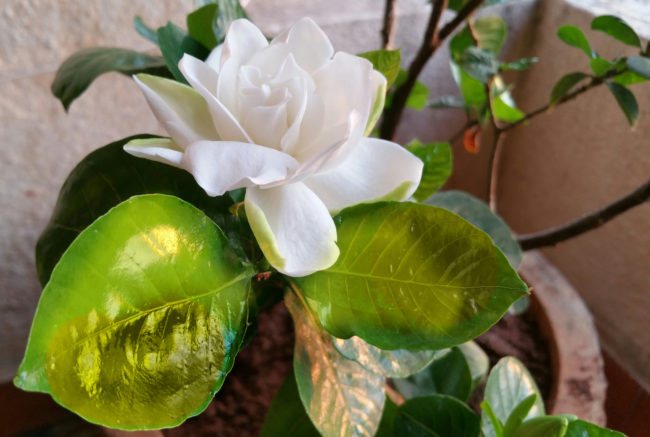
Gardenia leaves lose their usual green color and turn yellow for a number of reasons. Jasmine gardenia responds with yellowing of the crown to the following violations of the rules of agricultural technology:
- Incorrect watering;
- Unbalanced composition of the substrate;
- Chlorosis;
- Improper lighting;
- Depletion of the soil.
Improper watering will certainly cause changes in the condition of the houseplant. Both overflow and overdrying of the earthen coma have a negative effect. The soil in the flowerpot should always be slightly damp.
Drying of three to four centimeters of the upper layer of the substrate is considered the norm. Water for gardenia care requires preliminary preparation. The vast majority of city water supply systems supply hard chlorinated water, unsuitable for use without mandatory preparation.
Florists recommend keeping tap water in an open container for three days to free it from chlorine. It is allowed to use a household filter for this purpose. Boiling water helps to get rid of hard salts. Water for irrigation and spraying should be one degree warmer than room temperature.
The unbalanced composition of the substrate for growing gardenia affects the development of the plant. The tropical culture prefers a soil mixture with a slightly acidic reaction. Leaves turn yellow from lack of nutrition. Experienced growers use an azalea substrate that optimally meets the requirements of the jasmine gardenia.
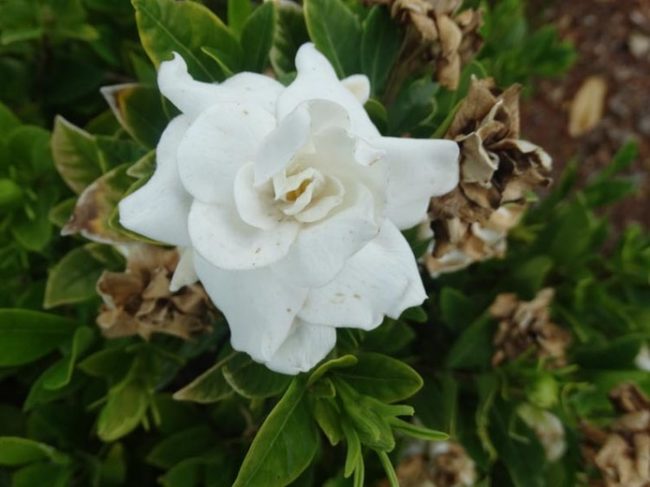

The root system of a tropical shrub does not assimilate micronutrients in the proper amount from neutral or alkaline soil. Chlorosis is a disease that affects the formation of chlorophyll in leaves. As a result, a decrease in photosynthesis is observed.
Certain symptoms indicate the presence of chlorosis:
- Leaves turn yellow and fall off;
- Small young foliage;
- Drying of the tops of the branches.
During chlorosis, yellowness captures the common part of the leaf plate, without affecting the veins and petiole. The most common cause of chlorosis in indoor gardenias is a lack of iron in the soil. The root system gradually depletes the substrate, causing the soil to alkalize. It is recommended to regularly use iron chelate, both for the prevention of chlorosis and its treatment.
Experienced growers necessarily bury two or three small metal nails into the substrate to compensate for the lack of iron. Improper lighting of gardenia always affects the aesthetic appearance of the crown. Gardenia leaves become dull, pale when there is a lack of sunlight. It is noteworthy that all foliage suffers, at all levels of the bush. Artificial lighting with fluorescent lamps will help correct the situation.
Depletion of the soil inevitably leads to the oppression of the growing season of all indoor plants. No amount of feeding will be able to compensate for a timely transplant. However, the lack of additional fertilization accelerates the depletion of the substrate. Gardenia is fed with a special complex of mineral fertilizers with a predominance of iron and magnesium.
Reproduction of gardenia jasmine at home
The area of flowering evergreen gardenia shrub is the tropics and subtropics of China, Asia and Africa. Gardenia jasmine home care requires special care. The slightest miss leads to shedding of foliage, fading and even to the death of a flower. On the windowsill, a plant can live from a year to seven years, depending on the observance of agricultural technology.
There are two ways of reproduction - seed and vegetative. For seed propagation, the freshness of the seeds is essential. They can be obtained independently in room conditions, after waiting for ripening. It must be recalled that gardenia seeds are poisonous.
The upper parts of the lignified shoots serve as cuttings. They take root in a greenhouse, in a sandy-peat mixture in summer, when they form a bush by removing part of the stems.The rooted plants are later transplanted into the prepared substrate, and after six months the young plant can bloom.
A common question that arises among gardeners is why do gardenia leaves turn black and fall off? To solve this problem, proper and competent gardenia care is required.
In order to avoid the problem of blackening and falling leaves in gardenia jasmine, proper care of the plant is necessary, so we recommend that you also watch this video.
Result # 2. Gardenia leaves fall
This also happens often. This is due to the stress that your plant has recently received.
The reasons:
1. Lack of watering
When gardenia begins to sprinkle with leaves, for example, they turn yellow sharply and crumble or fall off without changing their appearance, this is a consequence of drying. Regulate watering, and to combat stress, use spraying with an immunity stimulant - epin. It will not be superfluous to carry out "resuscitation" for the gardenia. Spray it with water or epin solution and put a plastic bag (garbage, for example) on the bush. Leave in this form for a day. This is a great way to quickly tidy up your dried gardenia.


Drying an earthen coma leads to leaf fall on gardenia
2. Draft
Gardenia leaves fall if it is "blown". Of course, gardenias lovers know that she loves coolness. However, it is not worth placing it near an open window from which it is blowing.
Acknowledgments
Someone said that writing a book requires loneliness, but it seems to me that the moment my pen touched a sheet of paper (in fact, my fingers on a computer keyboard) to draw the first lines of White Gardenia, on me the blessing came in the form of an incredible number of people willing to share inspiration and information with me and support the project.
First, I would like to thank the two women who inspired me to write a novel in which the main characters are Russians: mother Deanna and grandmother Valentina.
Features of the


The gardenia has leaves of a rich, dark green color, opposite, rarely in whorls of 3. There is also a peristo-loop venation and a cross-opposite leaf arrangement.
As you know, the foliage is still distinguished by triangular stipules, a smooth surface and a glossy shine. Foliage length up to 10cm. Among florists, gardenia is valued for the decorative appearance of foliage, an evergreen shrub looks spectacular, even in the absence of flowers.
What diseases affect the flower
If at least one rule of the disease is violated, a flower can overcome. The danger is represented by viral, fungal (rust, powdery mildew, various rot), bacterial diseases.
You can understand that the plant is sick by the leaves, more precisely, by the spots that appear on them.
Mealybug under a microscope.
A powdery coating on the underside of the leaves indicates a fungal disease called powdery mildew. If brown spots have appeared on the stems and foliage, it means that the plant is affected by rust, and if brown tubercles have appeared on the leaves, it is scab.
It happens that the leaves of a flower turn black. There may be several reasons for this. When the leaves turn black from below, this is the result of over-watering and tamping the soil in the pot. Because of this, the roots lack oxygen. It happens that due to frequent watering, drainage silts up. In this case, you need to well loosen the soil in the pot. Also from below, the leaves turn black due to excess fertilizer.
When the foliage on top turns black, it is possible that pests have appeared or the flower is sick. It is necessary to carry out the treatment of gardenia with the preparations mentioned above.
Viral diseases appear inside the leaf. In any disease, the lesion begins with the leaves. Their color changes, the spots increase, the leaves begin to fall off.Noticing the affected leaves on the flower, they must be immediately cut off and burned, and the gardenia must be isolated from other flowers and treated with special means.
If the plant is badly damaged, 3-4 treatments will have to be done. To prevent diseases, the flower can be treated 1-2 times with Abiga-Peak, colloidal sulfur or other means containing copper.
We must not forget that diseases can be carried along with the earth. In order for the gardenia to be more resistant to diseases, it is necessary to feed the plant in a timely manner with potash and phosphorus fertilizers.
As you can see, gardenia is a very capricious plant that requires daily attention and proper care. It takes a lot of work to grow a healthy, beautiful plant and get it to bloom.
Result # 4. Gardenia buds fall off
But this is very unpleasant. You are expecting that the recruited gardenia buds are about to open, and they fall off for no reason at all. It's a shame, but there are reasons for this.
The reasons:
1. Dry air
Gardenia is a plant native to the humid tropics. Loves humid air, refuses to bloom in dry climates and throws buds. Moisten the air around the flower. How to do it? For example, like this:
- Place the gardenia pot on a pallet of damp expanded clay. The pallet should be larger than the base of the pot so that moisture from expanded clay is transferred to the leaves;
- spray the gardenia more often, being careful not to get on the buds and opened flowers;
- place a jar of water next to the plant (indoor fountain, aquarium, etc.);
- use a humidifier.
Yellowing and falling leaves
1. The soil is too dry or too waterlogged. Gardenia can become covered with black spots if it is not properly watered. It is necessary to constantly monitor the condition of the soil in which the plant lives.
2. Drafts should be avoided, which have a detrimental effect on the gardenia.
3. Spider mite. In order to avoid its appearance, it is necessary to spray with water.
4. The action of the sun's rays. In the case when the plant is sprayed, it is necessary to ensure that exposure to the leaves of sunlight immediately after spraying leads to thermal burns and blackening. The best option is to provide diffused light.
If the gardenia leaves blacken and fall off, then when caring for a flower, it is advisable to follow the tips that must be followed.
If the gardenia leaves turn yellow and fall off, then here you can give such advice and recommendations.
1. Compliance with the watering regime. Overdried or, on the contrary, waterlogged soil leads to yellowing of the leaves with their further falling off.
Note! Watering is necessary for the plant after the top layer has dried to a depth of 1-2 phalanges of the fingers.
2. The quality of water for irrigation. Use well-settled or filtered (boiled) water. The water should not be cold.
3. The plant prefers an acidic environment.To do this, periodically water the gardenia with water and lemon juice or use substrates with an acidic reaction.
4. Chlorosis is a common disease in gardenia. Its appearance is associated with a lack of iron in the soil. In order to avoid the appearance of this disease, sprayers with iron-containing preparations are used (Ferovit, etc.).
5. Poor lighting. With a lack of light, the leaves begin to fade and fall off, so the plant should be provided with sufficient sunlight.
6. Drafts should be avoided.
7. During the period of growth and flowering, gardenia must be fed with fertilizers containing magnesium and iron.
What could be more beautiful than a blooming gardenia? Dark green leathery leaves and numerous white, highly fragrant flowers. How impatiently we are waiting for the moment when the first buds bloom on the gardenia sprigs and the room is filled with a pleasant jasmine scent. And how upset we are when the buds that have already appeared fall off, without giving us their beauty.
Dropping unblown buds and flowers is quite common when growing jasmine gardenia at home. This is due to the stress of the plant. Stress can be caused by various factors, such as changes in conditions of detention, diseases or pests.
The main rule that every gardenia grower must follow is that during preparation for flowering and flowering itself, you cannot move or rotate the plant. Even a slight change in lighting conditions can lead to the dropping of buds and flowers. Also, flowers and buds fall off with a sharp change in room temperature, too low or too high temperature, due to drafts, as well as due to severe waterlogging of the soil or, conversely, due to a lack of moisture in the soil and in the air. Due to too dry air, gardenia buds and flowers turn brown, dry out and fall off.
Very often, the cause of dropping buds and flowers is fungal and bacterial diseases and pests. Due to the high humidity and poor ventilation in the room, various parasitic fungi can settle on the leaves of gardenia, causing the appearance of brown and black spots. Charged leaves turn yellow pretty quickly and then fall off.
When buying a blooming gardenia at a flower shop or at a flower market, we think that it will bloom magnificently at home as well. And there is no limit to our disappointment when, after a few days, the flowers, as well as unblown buds, begin to fall off en masse. Why is this happening? There are several reasons.
One of them is unscrupulous sellers. It is important for the seller to sell the plant as soon as possible, before it loses its presentation. For this, plants are very often treated with various stimulants, keeping the plant attractive and healthy. At home, without regular stimulation, such a plant weakens very quickly, and sometimes dies.
The second reason is a sharp change in the conditions of keeping the plant. Gardenias grown for sale grow in greenhouse, ideal conditions, and it is difficult to create such conditions at home. Because of this, the home gardenia is under severe stress, which is the reason for the dropping of buds and flowers, and sometimes part of the leaves.
Result # 3. Gardenia turns black (leaves dry)
Gardenia leaves dry out quite often. If this happens in small quantities, then you should not worry - this is a completely natural process. You need to sound the alarm when the phenomenon is massive.
The reasons:
1. Bay
Dry the soil and adjust watering. Avoid "swamps" in the plant pot. Make drainage holes urgently if not available.
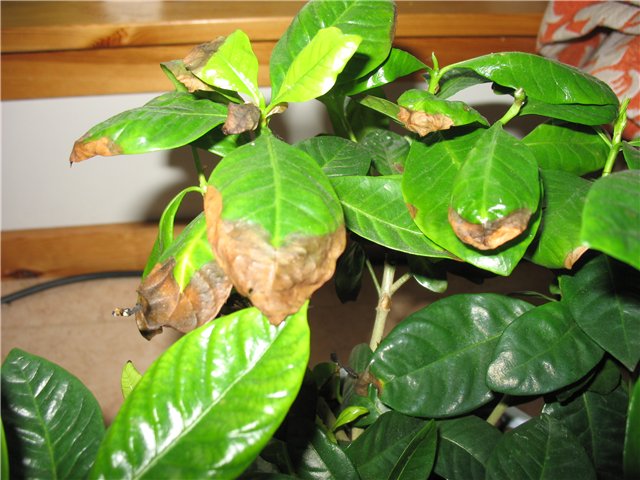

Gardenia leaves begin to dry out if the plant is watered too often.
2. Frostbite and draft
Gardenia is a sissy, so a sharp drop in temperature downward can cause blackening of the leaves. The optimal temperature range is 18-24 ° C.
3. Pests
Spider mites especially often hunt gardenia. It is he who causes the gradual blackening of the leaves, as it draws juice from them.


Manifestations of spider mites on gardenia
How to properly grow a jasmine gardenia from seeds
Expanded clay or coarse sand with small pebbles is poured into a wide bowl with drainage holes by a third. The soil for growing a school consists of equal parts of peat, sand and coniferous land.
The seeds are soaked for a day in growth stimulants. For growing from seeds, gardenia jasmine is laid out on the surface of the substrate and sprinkled on top with a mixture of half a centimeter thick. The earth is moistened from above with a spray bottle, covered and set in a warm, bright place. Soil temperature should be stable at 25 degrees. The shelter is periodically cleaned and the soil is moistened. The sprouts will appear in a month.
When the plant grows stronger and real leaves appear, they need to be planted in the smallest cups one at a time and covered until they take root. In the future, you will have to transplant more than once, until after two years the bush will bloom.
It is more profitable to propagate gardenia by jasmine cuttings, since flowering occurs faster, after six months.
Plant growing recommendations
In order for a flower to grow beautiful and healthy, you must follow some rules:
- do not keep the gardenia in direct sunlight;
- avoid sudden changes in temperature;
- do not flood the plant, but also do not let the earth dry out;
- maintain air humidity in the room;
- ensure the acidity of the soil;
- during the flowering period, do not change the position of the container with gardenia;
- water for irrigation should be slightly warm and soft;
- inspect the leaves daily for the timely detection of spider mites;
- sprinkle the leaves with water every day, and once a week with Epin (plant growth regulator).
Growing conditions for gardenia
The flower responds to the slightest changes in the environment and conditions of detention: air temperature, watering, indoor humidity, lack of fertilizers in the soil. Even inclement weather outside the window, when there is no sun, it rains, the sky is covered with clouds, causes a melancholy in the flower. And it is not surprising, because gardenia comes from the subtropics and prefers the sun. The plant refuses to bloom under unfavorable conditions and may shed the buds.
You can prevent the ovary from falling off if you maintain a certain temperature (about 20 ° C during the day, 17-18 ° C at night), do careful watering and ventilate the room where the gardenia grows. When ventilating, avoid drafts.
Frequent spraying of the plant helps the lack of moisture.
The plant reacts to unfavorable conditions by yellowing the leaves. When the lower leaves turn yellow, the soil in the container is too moist or the plant is in a draft. The flower loves moisture, and in hot weather it must be sprayed, but not watered at the root. Frequent watering can cause root rot and the development of diseases. And the leaves will immediately let you know about it - they will begin to turn yellow and gradually fall off.
If this happens, it is necessary to limit watering to 1 time per week, loosen the soil well and make sure that the plant does not stand in a draft. After that, watch the flower. If the gardenia no longer has yellowing leaves, the danger has passed, you can breathe a sigh of relief.
If yellowing continues, the plant should be immediately transplanted into another container. In this case, cut off the rotten roots, treat the remaining ones with potassium permanganate. In a new container, drain it by filling it 1/3 with pebbles. After transplanting, do not water the flower for about a week, and then water it once every 7 days.We must prepare for the fact that the gardenia can shed all the leaves. When the gardenia leaves turn yellow at the top, there is an abundance of lime and chlorine in the ground. The flower should be planted in another land and not use fertilizers that contain lime.
Water the gardenia with rainwater or chilled boiled water. The water should be warm. When the leaves turn yellow and fall off (no matter which ones are top or bottom), this means either a lack of sunlight or a deficiency of nitrogen in the soil.
Description
The leaves of the plant are glossy, opposite, rarely 3 in whorls. They have triangular stipules. In addition, they have a peristo-loop venation, the arrangement of the leaves is cross-opposite. Even without flowers, the bush looks decorative because of the dense, leathery leaves of a dark green hue. They have an oval shape and pointed ends. In length they reach up to 10 cm.
What caused the appearance of yellowness?
This is the most common plant problem. The leaves turn pale, turn yellow, sometimes only between the veins. All of this points to the wrong content. There can be many reasons.
Improper watering
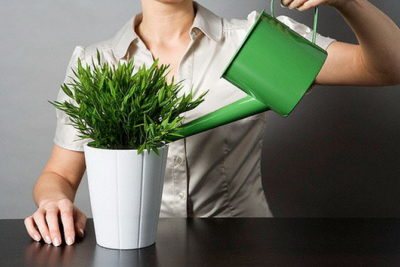

Often, gardenia acquires yellow leaves due to excessive moisture in the soil or due to its strong drying out. Watering is required immediately after drying the upper layers of the soil for 1-2 phalanges of the finger. You should not wait until the earth clod completely dries out.
Water also plays an important role. The plant needs only settled water, or better, passed through a filter or boiling. And it should be warm. Hard and cold water will not work. To solve the problem, you need to adjust the watering, monitor the drying of the top layer, and properly prepare the water.
Incorrectly selected substrate
Gardenia grows well in acidic soils, it does not do well in the rest. In alkaline soils with neutral pH, the roots do not assimilate important elements.
A substrate with a pH of 4-5 is sold in a special store, it is called "Gardenia" or "Azalea".
Needles of coniferous trees can be added to the finished mixture to acidify. But even acidic soil alkalizes due to the nature of the water. In order to prevent this, you will need to water the plant with acidified water every 10 days.
For this:
- dissolve 2-3 crystals of citric acid in 1 liter of water;
- sorrel acid in the amount of 1/3 tsp. insist 3 liters of water for 3-4 days;
- mix lemon juice with 1 liter (2-3 drops are needed);
- mix 200 g of peat with 3 liters of water for 1 day.
Chlorosis
This problem is manifested by uneven yellowing. The veins remain green and the background turns yellow. Chlorosis is caused by insufficient iron content in the soil. To carry out the prevention of this disease is required constantly, tk. it is almost chronic in gardenia. A disease appears when the soil is alkalized, therefore, for prevention, the plant is watered with acidified water.
If bright signs are noticeable, then the actions are as follows:
- spraying and watering with preparations containing iron;
- self-preparation of iron chelate;
- as an additional source, you can bury rusty nails in the ground.
Lack of lighting
Leaves also turn yellow due to insufficient light. In such a situation, the leaves can fade evenly on all branches. To solve the problem, additional illumination with phytolamps or fluorescent lamps should be provided.
Malnutrition
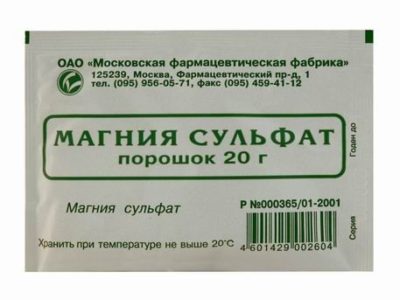

Like other plants, gardenia requires feeding during growth and flowering. For this, a special fertilizer with magnesium and iron (complex) is suitable. Gardenia has a special need for these elements. An insufficient amount of magnesium, like iron, causes the leaves to become lighter.
You can eliminate the problem with the use of magnesium sulfate, which is suitable for spraying in a proportion of 20 g per 10 liters of water.
From the author
It is customary for Russians to refer to each other by name and patronymic. For example, in "White Gardenia" Ani's full name is Anna Viktorovna Kozlova.Viktorovna is a patronymic produced on behalf of her father, Viktor, and Kozlova is the female form of the Kozlov surname. If they were polite, they would call her Anna Viktorovna, but among her family and friends she would just be Anya.
To avoid this confusion, in order to preserve the Russian flavor, I decided to mention the patronymics of the characters only in certain cases: in letters, in Sergei's will, at the official presentation, etc. Most often I used short forms of names. In addition, I decided that Anya would keep Kozlova's surname in Australia, although in real life she might prefer to drop the feminine ending from her surname and become just Anya Kozlov.
Perhaps the most exciting thing about White Gardenia was the attempt to show that, despite the tragic events that took place in the world, an invisible but strong bond remained between mother and daughter. I tried to adhere to a real chronology and accurately reproduce the surrounding world in which my characters lived. However, in several places I had to take on the role of God and in order to keep the plot flowing to speed up the story a little.
The first example is the visit of my heroine Ani to Shanghai shortly after the end of the Second World War. Chronologically, the Americans could be in Shanghai at that time, but Anya arrives there a few weeks before the arrival of the main units of the American navy and, accordingly, before the screens for showing newsreels were built by the hands of the sailors and life in the city began to boil again.
Since the main purpose of this episode was to portray the jubilation at the end of the war and to show how quickly Shanghai could be reborn, I considered it possible to make these events coincide in time. Once again, I disposed of the story at my own discretion in the part of the book, which is devoted to the life of refugees on the island of Tubabao.
George Burns once said: “The most important thing in the art of an actor is sincerity. Someone who can play sincerity can be considered a good actor. " In "White Gardenia" it was sometimes more convenient to place the characters not in real-life places, but in fictional ones. Firstly, this is the Moscow-Shanghai club. Although this nightlife is a figment of my imagination, inspired by the architecture of some of the royal palaces, it nevertheless fits well with the decadent spirit that reigned in Shanghai at that time.
The same goes for the resettlement camp in Australia, to which Anya and Irina were sent. In my design, it is not a direct analogue of the actual camp in central NSW, although most of the research for the chapters on this topic has been conducted around the camps in the cities of Bathurst and Carpet. The fact is that I needed Anya to develop a very close relationship with the head of the camp, and I felt that I had no right to introduce into the novel the hero who became the prototype of the real head of the camp, since the narrative touches upon the personal level.
For the same reason, Anya works for the fictional Sydney Herald newspaper, and not for any of the Australian newspapers that actually existed at the time. I wanted Ani to develop a trusting relationship with editor Diana. The high society families depicted in the novel are also fictional, since it was not my purpose to portray any of the people who lived at the time, although in the 50s clubs named Princes, Romanos and Checkers did use in Sydney popular.
I can explain my approach to using real and fictitious names and names with the words of one of my friends, a terrible fashionista: “The main thing is that you match the color of your hair and shoes, you don't have to think about everything between them”.In other words, since the historical context of my book and the description of the characters' everyday life (what they ate, wore, read) are true, I can afford to “play” with the plot.
In this regard, I want to add that, although I was inspired to write this novel by the stories of my mother and grandmother about their journey from China to Australia, all the characters and situations described in it are a product of my imagination. This book is not a story of my family in a fictional form, and none of the main characters has a real prototype, both among living people and among those who have already left this world.
The research work and the very process of writing "White Gardenia" was a great pleasure for me. I hope you enjoyed reading it as well.
Why do they turn black and fall?
If you deviate from the standards of care, there are health problems in the plant. The foliage turns black, becomes stained, and soon falls off. First, we determine the causes of such a phenomenon, then the methods of elimination.
Excess moisture
IMPORTANT: Daily hydration or large amounts of fluid used can have similar effects. Also, the accumulation of water in the pot signals a poor-quality drainage layer or its absence.
In fact, gardenia loves moist, but not wet soil, which, if not taken care of, will rot the roots. If, 15 minutes after watering, the water is on the surface of the soil, then there are problems with the substrate.
What to do?


Remove the plant from the flower container.- Carefully examine and feel the root system.
- Cut off black, rotten roots with a sharp instrument.
- Remove blackened leaves in the same way.
- Disinfect the sections.
- Treat the plant with a weakly concentrated fungicide solution.
- The following drugs are used: "Fundazol", "Ferazim", "Uzgen", "Benomil".
- Transplant the flower into new soil. A drainage layer is required.
- Do not water immediately after transplanting.
- Place the plant in greenhouse conditions for 3-4 weeks, cover the pot with a plastic bag.
- Remove from the sun, regularly ventilate, water.
Hypothermia
Gardenia is a thermophilic flower, and with drafts and a sudden drop in temperature, the foliage bends down lifelessly, darkens. This can happen when transporting indoor exotic from the store, in the cold season. Or when frosty air enters the room and directly on the plant.
What to do?
If hypothermia is not significant, then the flower restores elasticity on its own. In the future, exclude the presence of drafts, low air temperature. Optimal conditions are + 20-24 ° С.
Difficulties and solutions
Improper care and non-compliance with the basic requirements for maintaining a flower leads to a variety of problemsoften encountered by gardenia owners.
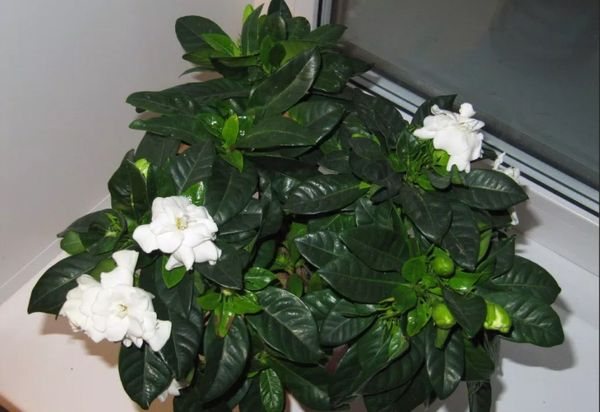

If such a flower gets sick, it is important for the florist to immediately find the causes of the disease.
If the leaves turn black and fall
Overflow and direct sunlight on the leaves can lead to their blackening and subsequent fall. If the culture has been flooded, then it is recommended to immediately transplant it into a new pot.
Decay of the root system - this is the reason for the blackening and falling off of the cover.
Overdrying the soil also fraught with blackening.
If the temperature drops sharply, then blackening of the leaves is also likely. A draft can also lead to this. The optimum temperature for keeping gardenia jasmine is around 20 degrees, but not more than 25.
Often leads to blackening infection plants spider mite... It can be identified by a whitish bloom in the form of a cobweb. This pest is treated with insecticidal preparations or soap solution.
Why do the leaves turn yellow
The main reasons for yellowing of leaves:
- Changes in air temperature;
- Wrong watering regime;
- Wrong substrate.
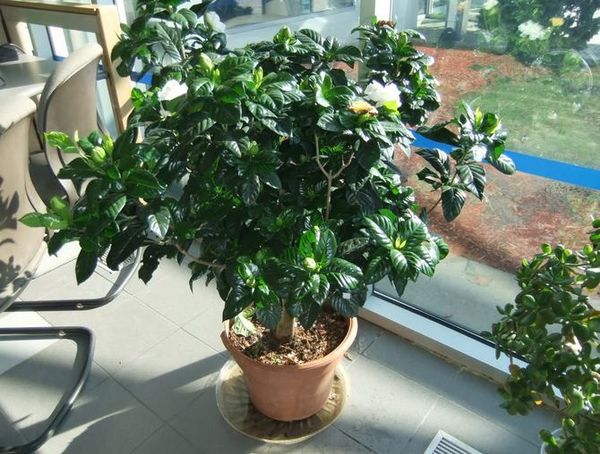

Adjusting watering and temperature microclimate is the direct responsibility of the grower
Thus, it is necessary to establish the temperature regime and watering of the gardenia. You can not both pour and overdry the culture. The top layer should dry out between waterings, but it is impossible to allow the soil to completely dry out.
To purify water from chlorine, it is recommended to filter it, boil it or settle it for several days.
As for the substrate, the gardenia loves acidic soilsbut excessive acidity will lead to yellowing of the leaves. Iron chelate can be added to reduce acidity. In neutral and alkaline soils, gardenia will not do well.
Leaf plates turn yellow
Why?
- Wrong watering regime. The soil dries out or is regularly moistened with excess liquid. Inappropriate water quality.
- Incorrectly selected soil. Gardenia prefers acidic soil, in the rest it will feel uncomfortable, alkaline and neutral substrates prevent the absorption of necessary substances.
- Chlorosis arising from alkalization of the soil.
- Lack of lighting.
- Lack of food.
- Defeat by the scabbard.
- Excess chlorine and lime in the soil.
Diagnostics
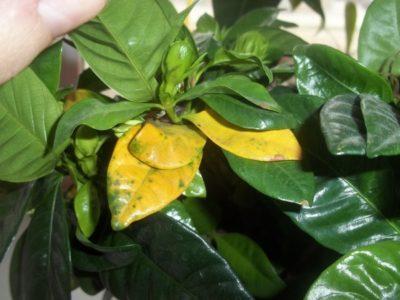

The leaf plate turns yellow completely or only between the veins.- The plant withers, leaves turn yellow and fall off.
- The leaves become lighter, gradually turning into a yellow tone, the tips of the leaf plates turn yellow intensely, while the veins remain green, and white spots may also appear on the leaves.
- The leaves fade evenly on all branches of the bush, gradually acquiring a yellow tint.
- The leaves become pale, gradually turning yellow.
- The leaves turn yellow and brown spots appear on the back, which are easy to remove.
- Leaves on the top of the bush turn yellow.
What to do?
- It is necessary to water the gardenia immediately after drying the soil on one or two phalanges of the finger, depending on the size of the plant and the container in which it is planted. You can't wait for the earthen coma to dry completely. For irrigation, use only warm, well-settled, boiled or filtered water.
- It is necessary to transplant the gardenia into a soil specially created for it. You can buy it at flower shops. Azalea substrate is also suitable. For additional acidification, you can mix coniferous needles into the substrate yourself.
So that over time there is no change in the reaction of the soil, every ten days it must be watered with acidified water. To prepare such a solution, you can use citric or oxalic acid or lemon juice. - Watering and spraying gardenia with iron-containing preparations.
- The flower should be placed on the windowsill from the east or west side so that the amount of light is sufficient, but there is no risk of burns from direct sunlight.
- During the period of growth and flowering, gardenia needs additional feeding. You need to choose a complex fertilizer with an additional magnesium content.
- In the initial stages of the disease, you can help the plant by treating it with a swab dipped in alcohol, if the lesion is extensive, you need to apply insecticides.
- An urgent transplant into a new soil is required.
[collapse]
Result # 1. Gardenia leaves turn yellow
This is the most common gardenia ailment. The leaves turn pale, turn yellow, sometimes - only between the veins. In any case, such manifestations indicate unfavorable conditions for keeping the plant.
The reasons:
1. Wrong watering regime
Very often, gardenia turns yellow when the soil is excessively moistened or, conversely, after drying. Watering is needed immediately after the top layer of the earth dries up by 1-2 phalanges of a finger (depending on the size of the plant and the depth of the pot), it is impossible to wait for the complete drying of the earthen coma.
Water quality also plays a huge role and can easily lead to yellowing of gardenia leaves.A capricious plant recognizes only well-separated, ideally boiled or filtered (from chlorine) water. And only warm! Cold and hard water is not suitable.
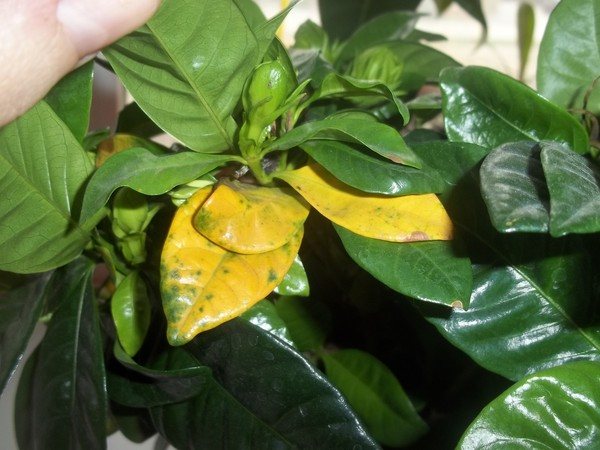

Yellowing of gardenia leaves due to overflow
2. Wrongly chosen substrate
When thinking about why gardenia turns yellow, do not ignore the substrate in which it grows. Gardenia prefers acidic soils; it will feel bad on all others. In neutral and, especially alkaline, substrates, its roots cease to assimilate the necessary substances to the required extent.
An acidic substrate (pH 4-5) can be purchased at a flower shop called Azalea or Gardenia. In the finished substrate, you can independently mix coniferous needles - for additional acidification.
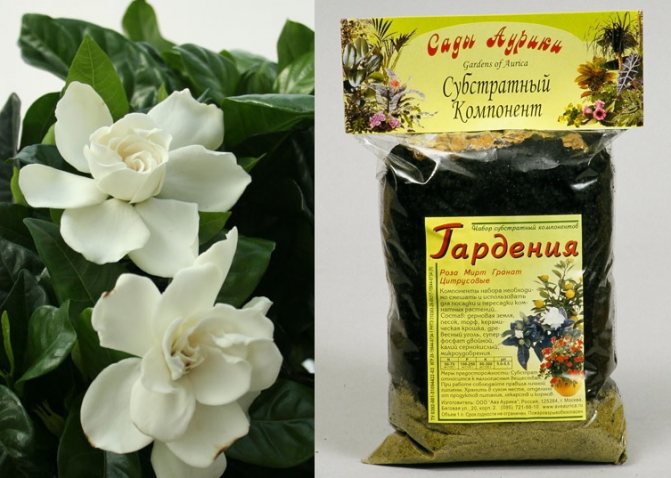

Gardenia soil must be acidic
Unfortunately, even acidic soil alkalizes over time. Tap water is alkaline in most regions. To prevent changes in soil response, water the gardenia with acidified water every 10 days. For acidification use:
- Citric acid - several crystals (at the tip of a knife) are dissolved in 1 liter of water;
- Oxalic acid - 1/3 tsp for 3 liters of water, after which it is insisted for at least 3-4 days. Oxalic acid is good in that it not only acidifies water, but also precipitates calcium salts, an excess amount of which is harmful to most plants;
- Lemon juice - 2-3 drops per 1 liter of water;
- Peat - 200 g of peat is poured into 3 liters of water, insisted for a day.
3. Chlorosis
Chlorosis manifests itself in uneven yellowing of gardenia leaves: the veins remain green against the background of yellowing, sometimes almost discolored, plates. Chlorosis is associated with a lack of iron in the soil. By the way, chlorosis in gardenia is almost a "occupational disease", the war with it must be constantly waged, otherwise the flower will surely hurt.
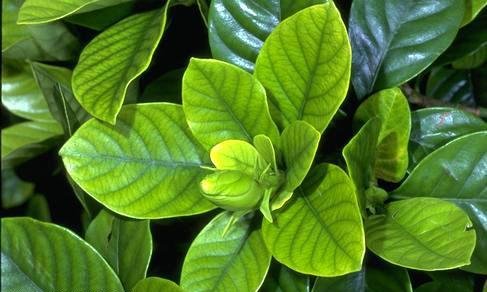

Iron chlorosis of gardenia
Chlorosis occurs when the soil is alkalized, so the first step for prevention should be watering the gardenia with acidified water. With clear signs of chlorosis, proceed as follows:
- spray and water gardenia with iron-containing preparations (Ferovit, Micro-Fe, etc.);
- or make homemade iron chelate;
- as an additional source of iron - bury rusty nails in the soil.
4. Lack of lighting
Gardenia turns yellow even with a lack of light. In this case, the leaves turn pale, and evenly, on all branches of the bush.
5. Lack of nutrition
Gardenia, like any ornamental plant, needs additional feeding during the period of growth and flowering. Find a good compound fertilizer with additional iron and magnesium. Gardenia has a special love for these two trace elements. We already wrote about iron above - gardenia reacts to its lack by yellowing the leaves (chlorosis). Lack of magnesium also leads to blanching of the leaves. Magnesium sulfate used for spraying at a concentration of 20 g per 10 liters of water will help to eliminate this process.
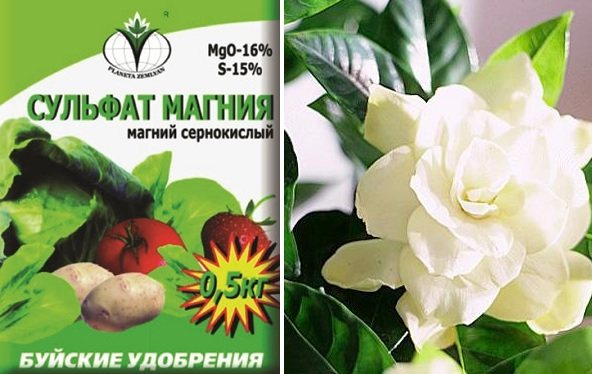

Magnesium sulfate heals the plant, accelerates and enhances flowering
Gardenia is losing leaves
Certain violations of the rules of care cause the loss of leaves of the plant without disturbing the color. Gardenia leaves can fall partially or completely. You should not sound the alarm if one leaf has dried up. However, you should reconsider the care of the gardenia if most of the crown wilts. It is not uncommon for leaf fall to be accompanied by the loss of buds, which is also a symptom of violations of specific rules of care.
Foliage loss can be caused by:
- Dry air
- Drying out of the substrate.
- Hot Summer.
- Direct sunlight.
- Moving the flowerpot.
- Untimely transplant.
- The slightest stress causes the leaves to fall off.
Knowing what to do in each specific case, you can save the plant from death:
- Gardenia sheds leaves due to too dry air, drying out of the substrate, high air temperature.The reason for insufficient air humidity can be a hot summer, heating radiators. Gardenia is sprayed more often during the heating season. No less effectively humidifies the air with a container of water installed next to the flowerpot.
- In hot weather, gardenia is watered more often. Excess water must be removed from the pan. In hot summer, it is necessary to shade the bush from direct sunlight.
- It should be remembered that a subtropical flower is afraid of drafts, sudden changes in air temperature, and changes in lighting. It is imperative to provide your gardenias with stable growing and care conditions. Gardenia takes time to master in new conditions. It is very appropriate to treat the plant with an anti-stress drug "Epin" according to the instructions.
- Inexperienced florists often ignore the period of compulsory adaptation of the newly acquired specimen. Acclimatization to a new microclimate lasts at least two weeks. During this period, the plant cannot be transplanted. The supply of the transport soil is sufficient for initial adaptation. Any changes in the growing conditions of gardenia cause not only the fall of leaves, buds and flowers.
It is strongly discouraged to transplant during the flowering period, as stress will necessarily lead to the loss of buds.
If the roots are damaged and partially brown
The condition of the plant is satisfactory and can still be saved. It is necessary to remove the bad roots and transplant into fresh soil.
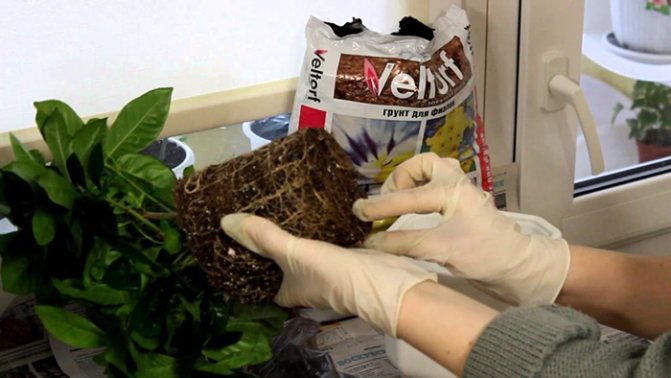

Gardenia transplant
If the roots are soft and brown, the flower, unfortunately, cannot be saved.
Any factor that stimulates wet soil conditions, including poor drainage and irrigation, contributes to disease development. Planting too deep also contributes to this problem. The most common problem is frequent watering - the plant has too much water.
The best way to prevent root rot problems is to inspect the roots of the flower before purchasing. You also need to make sure that there is sufficient drainage in the area where the gardenia will be planted.
The most interesting about gardenia
Gardenia is very sensitive to the slightest carelessness of the grower. As the true queen of the windowsill, she sheds buds, turns yellow, loses leaves and has earned the title of a capricious and very demanding indoor plant. Gardenia generously rewards the diligent and disciplined grower with the flowering of fragrant flowers.
Understanding the symptoms allows you to correct mistakes in agricultural technology as soon as possible and save the houseplant.
Most often, gardenia reacts to care disturbances:
- Blackened leaves.
- Leaves of yellow color.
- By dropping foliage.
- Loss of buds and flowers.
Often, a slight correction of fertilizing, lighting, irrigation regime allows the gardenia to return to its healthy appearance and harmonious development.
Gardenia care rules
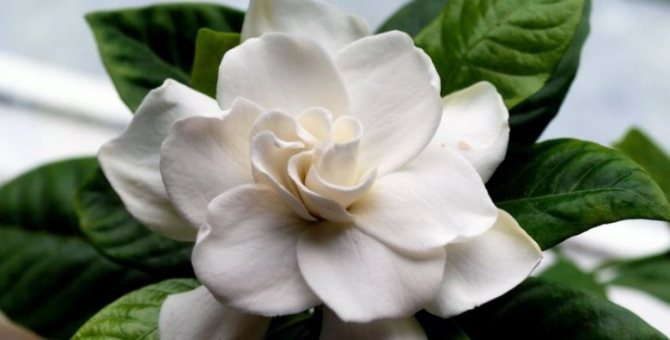

- Do not expose the gardenia to direct sunlight;
- protect from sudden temperature changes;
- provide the plant with high air humidity;
- do not allow the earthen coma to dry out (even a single one) or excessive watering;
- constantly maintain the acidity of the soil;
- do not rotate or carry the plant pot from place to place during flowering;
- water the plant only with soft water;
- regularly inspect the lower surface of the leaves for spider mites;
- once a week arrange a gardenia "bath" by placing a pot with a plant in a bowl of water with vinegar added (100 grams per 10 liters of water) for 20 minutes;
- spray the leaves with water every day, and once every 4 days - "epin".
Falling buds can be prevented by observing the temperature regime. Gardenia needs 18 - 20 ° C during the day and 16 - 18 ° C at night. This should be accompanied by careful watering and regular ventilation of the gardenia area. When ventilating, care must be taken to avoid drafts.
Pests and ways to deal with them
In addition to diseases, gardenia is susceptible to attacks by various pests.
White aphid
A harmful insect that affects plant stems and foliage. It is often the reason why the buds fall off. You need to know that this insect reproduces very quickly. When it appears, you need to urgently take measures to destroy pests.
Spider mite
This is the main enemy of the tropical beauty. Together with him, the plant is also threatened by the scale insect. To get rid of pests, it is necessary to periodically wipe the sheet plates with a napkin or cotton pad moistened with water.
This will help provide comfortable air humidity around the flower and detect the presence of pests and their larvae.
If shoots are found affected by spider mites, they must be removed immediately. This pest infects flowers when the humidity in the room where they are located is too low. For preventive purposes, they need to be sprayed regularly.
If a pest appears, it is required to treat the leaves with special insecticides. This will save your gardenia from spider mites for a long time.
Shield
To combat the scabbard, washing the leaves with a mild soapy solution is great. For greater efficiency, repeat the treatment after a week. To avoid contamination of other plants, the affected ones must be isolated.
Signs of improper gardenia farming
Jasmine gardenia requires patient care and does not tolerate carelessness and fuss. A flower grower who has mastered the cultivation and care of gardenia at home will certainly be rewarded with a lush bloom of fragrant rose-like flowers.
Most often, the leaves of gardenia jasmine turn black and fall, which puzzles novice collectors of indoor plants. Color changes and loss of foliage are not the only symptoms of distress.
Among the signs of improper agricultural technology are:
- Chlorosis, yellowing of leaves;
- Falling foliage;
- The crown of the gardenia turns black;
- There is no flowering;
- Gardenia sheds buds.
Often, the same symptom has several causes. A demanding houseplant reacts negatively to deviations with some delay. Flower growers have time to forget the events of two weeks ago, which caused a negative reaction from the gardenia. The response of gardenia to unfavorable growing conditions is delayed by two weeks.
Other diseases
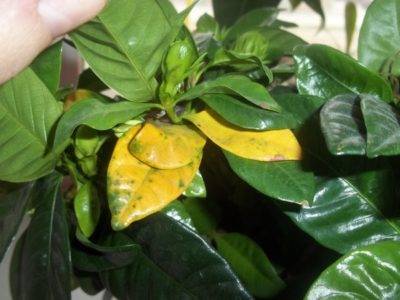

Chlorosis - this disease is quite common in gardenias. We can say that this is their occupational disease.
It occurs as a result of a lack of iron in the soil, as well as during its alkalization, irrigation with poor-quality water, with a high content of chlorine and other alkaline elements.
The symptoms of chlorosis are yellowness, discoloration of the leaf plate of the plant.... In this case, the veins remain green.
What to do?
- Spray regularly and add preparations containing iron, for example "Ferovit", with a solution of copper sulphate under the root.
- It is possible to use a self-prepared iron chelate solution.
- Apply the folk method: "plant" a rusty metal part, a nail, a pin in a gardenia pot.
Read more about gardenia diseases and pests in this article.
Gardenia is a delicate flower, don't move it often... The plant likes to be on its windowsill, where there is no cold air, drafts, and the scorching rays of the sun. Also, the plant will not refuse regular watering with acidic water and feeding with iron and magnesium. Do not neglect the wishes of an exotic beauty.
dacha.expert
Description of the plant
Gardenia is a heat-loving plant that grows in the south. Demanding to the conditions of their content. Growing this decorative indoor flower is very troublesome.
It is not uncommon for flower growers to take risks by buying it for their winter garden, but the time and effort spent on leaving is not without a reward.He thanks his owner for a long and abundant flowering.
The plant reacts very violently to any external stimuli and care features. The cause of the disease can be improper watering, poor lighting, low temperature in the room where the flower is located, low humidity and many other reasons.
In case of any diseases, the plant loses its decorative effect. His leaves turn yellow and dry, and in some cases even turn black, buds fall off.
Growing features
The plant is quite demanding on the conditions of detention. Novice gardeners may face difficulties caused by watering, lighting, fertilizing, and the composition of the soil for transplanting.
Gardenia does not tolerate at all when it is rearranged from one place to another, even the pot cannot be turned, because leaves and buds may begin to fall off.
Important. The plant must provide all the conditions necessary for a comfortable existence. If this is not done, quality development and long flowering can never be expected.
What to do if gardenia dries up more and more every day
Since gardenia is jasmine, like any other, a rather capricious plant, it can dry out for a variety of reasons, which are usually associated with errors in content... If this happened, then while it has not completely dried up, you can try to save the flower in the following way:
- You need to inspect the gardenia and cut off any shoots that are completely dry;
- Prepare acidified water and spray abundantly;
- Cover the plant with a plastic bag and place in a place with good lighting;
- After a week, carry out treatment with a growth stimulant (Epin, Zircon).
In the future, you need to strictly adhere to all care recommendations.
The most common gardenia pests
Tobacco thrips and other thrips are common gardenia pests. The injury manifests itself in the silvery color of the leaf, because thrips suck up vegetable juices. These insects are very small and can be difficult to see on the underside of the leaf without additional equipment.
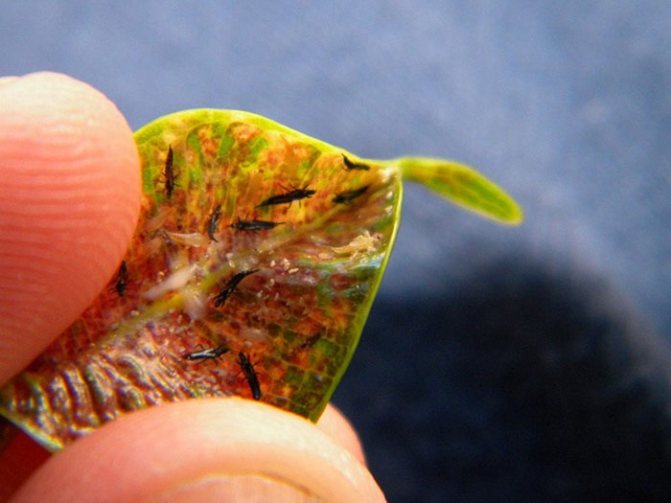

Different types of nematodes (microscopic roundworms) feed on the roots of gardenia. Aerial symptoms of root damage from such diseases include wilting in hot, dry weather with improved flower condition at night. Leaves can show yellow spotting and other signs of malnutrition. Over time, the plant can become stunted and exhibit branch dieback. Root damage can include stunted growth, discoloration, excessive branching, or the presence of small tumors in plant tissue.
There are many natural ways you can use to get rid of gardenia pests. One of the most effective and safest options is to use diatomaceous earth or a food product that contains vitamins D and E. This natural pest control helps eradicate a wide range of insects.
Certain essential oils, such as neem oil, can help address common pest problems. Peppermint oil from various beetles, parasitic wasps, ticks, caterpillars, and other pests. On the other hand, cedar, hyssop, and pine essential oils retain mucus and snails in flower beds. The introduction of beneficial insects into your own greenhouse that feed on pests of the vegetable garden will also help solve the problem of infection.
Pests act
If all possible shortcomings in gardenia care are excluded, then perhaps the leaves and buds fall off because they were attacked by flower pests. Signals to search for harmful insects can be white bloom, spots, cobwebs and stickiness of leaves. Most often these are thrips, scale insects, mealybugs and spider mites.How to identify gardenia diseases? What can you do to stop them?
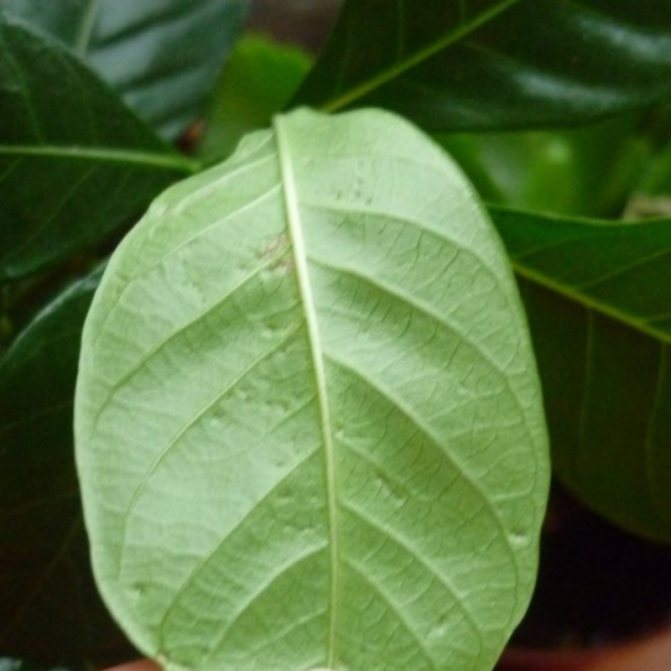

Thrips on gardenia leaves
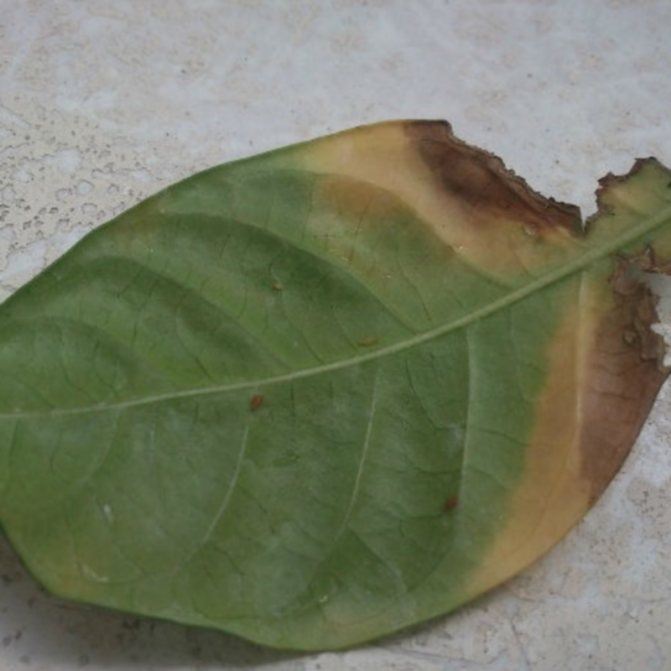

Scabbard on gardenia leaves
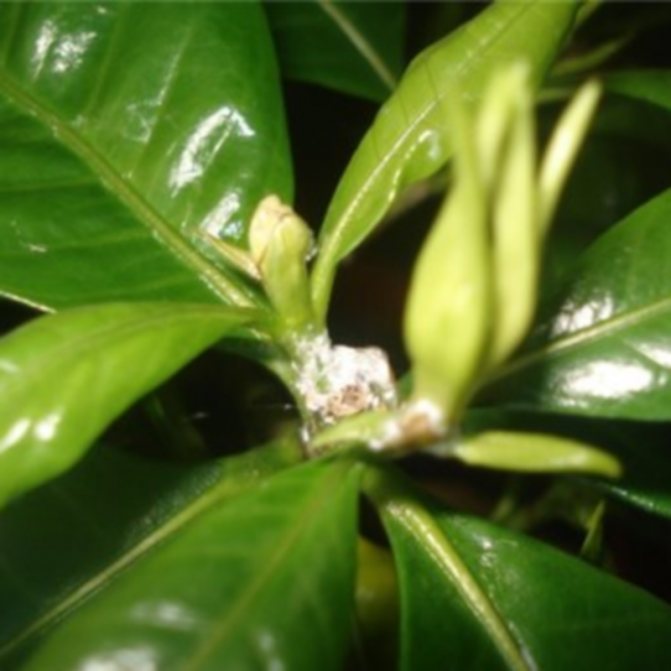

Mealybug on gardenia leaves
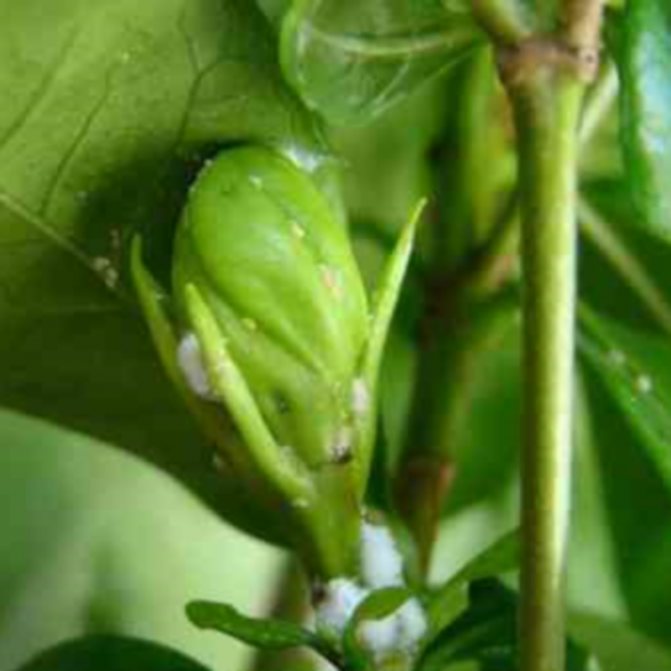

Spider mite on gardenia leaves
- On close inspection from above, small pale gray spots can be seen on the leaf plate. It is wielded by small pests -thrips... It is urgent to remove the affected leaves. Wipe the remaining leaves with soapy water and treat with insecticides.
- If you saw small brown spots on the leaves of the gardenia and the leaf became pale and sticky, then the plant was hit scabbard... In this case, the flower is immediately separated from the entire collection. The shield is removed with a cotton swab dipped in soapy water with the addition of a few drops of alcohol or kerosene. Then spraying is necessary - dilute 10 ml of thiophos in 1 liter of water.
- Young, twisted leaves have a white powdery coating. This indicates the presence mealybug... White plaque must be urgently washed off with soapy water. If the lesion is too large, then treatment with an insecticide is recommended - Actellik, Confidor, Biotlin.
- Spider mite envelops the drooping leaves and stems of the gardenia in silky cobwebs. Usually a tick is triggered by too dry air. The plant is treated with insecticides, sprayed with Malathion solution.
In any of these situations, it is necessary to isolate the infected specimens as soon as possible so that the pests do not spread to healthy flowers. If you do not want to use chemicals, turn to folk remedies - garlic solution (2 cloves per liter of water), tobacco infusion (70 grams of tobacco, 5 grams of soap per liter of water). Spray at intervals of several days for a month.
What it is?
Gardenia comes from the madder family. This genus includes up to 250 species, but The most popular domestic flower is Gardenia Jasmine. It boasts waxy white flowers and jasmine scent. All varieties are evergreen and flower for several months.
We talked more about the types and popular varieties of gardenia in this article.
What causes gardenia leaves to turn black
A harmoniously growing gardenia bush has dark green foliage with a slightly glossy surface. Violation of the rules of agricultural technology causes the loss of leaves, their yellowing or the appearance of blackness. Thus, the houseplant informs about the need to correct the care at home.
A correct understanding of the symptoms allows you to pinpoint the cause of the problem. Timely elimination of unfavorable factors contributes to the rapid restoration of jasmine gardenia with minimal losses. The valuable experience of fellow florists will help you navigate among the mass of guesses and assumptions.
Turn black
The reasons
- Excessive waterlogging.
- Frostbite and draft.
- Spider mite.
- Rotting of the root system resulting from fungal infections.
- Cramped pot.
Diagnostics
- At the plant, the tips of the leaves or the entire leaf plate turn black.
- The leaf plate turns black and curls slightly.
- The leaves turn black gradually as the insect sucks the juice out of them.
- A black sooty film appears on the leaves.
- The leaves turn black at the base, while the roots are tightly braided with an earthen ball and adjoin the walls of the pot.
How to treat?
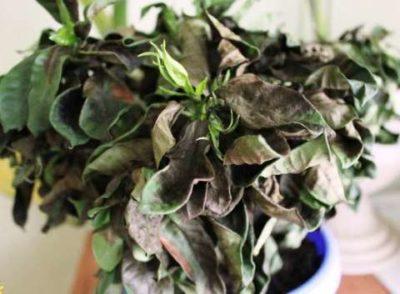

It is necessary to dry the soil and adjust the watering. Make drain holes in the pot if missing.- Sudden temperature fluctuations should not be allowed. Optimal frames + 18 + 24 degrees.
- The pest attacks the plant when it is exposed to dry air and high temperature. It is necessary to adjust the gardenia keeping regimen and treat the flower with insecticides.
- In order to assess the real condition of the roots, you need to remove the flower from the pot and examine them. Healthy roots are white, rotten ones are brown.All affected parts of the root system must be cut off, sprinkled with crushed charcoal or activated charcoal and planted in a smaller pot if the previous container was too spacious and caused moisture stagnation, which is a beneficial condition for the growth of fungi.
- The plant will be helped by transplanting using the transshipment method.

